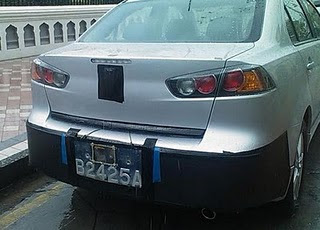New Proton Waja Lancer photos!!!
R i d e s
All about rides
Sunday, August 29, 2010
Wednesday, August 18, 2010
BO Hatchback Compact EV
The market trend in the automotive industry is moving toward electric cars, and Italian auto design house Pininfarina is among the companies who will be coming out with their line of electric models.
The B0 or B Zero is Pininfarina’s five-door hatchback compact EV which was designed to be a solution to have a cleaner world. The B0 was unveiled at the Paris Mondial de l’Automobile 2008 in honor of Pininfarina’s late chairman and chief executive Andrea Pininfarina.
The production of B0 will be a collaborative project between Pininfarina and the Bollore Group, with the latter company in charge of producing the supercapacitators and the LMP or lithium-metal polymer battery pack to be used in the B0. For those who don’t know, the LMP battery pack is placed beneath the car floor and works to ensure that the weight distribution is balanced. Among the advantages of using the LMP battery pack is that it’s rechargeable in just a few hours, has high energy density, has a service life of 125,000 miles, and is maintenance free.
The market trend in the automotive industry is moving toward electric cars, and Italian auto design house Pininfarina is among the companies who will be coming out with their line of electric models.
The B0 or B Zero is Pininfarina’s five-door hatchback compact EV which was designed to be a solution to have a cleaner world. The B0 was unveiled at the Paris Mondial de l’Automobile 2008 in honor of Pininfarina’s late chairman and chief executive Andrea Pininfarina.
The production of B0 will be a collaborative project between Pininfarina and the Bollore Group, with the latter company in charge of producing the supercapacitators and the LMP or lithium-metal polymer battery pack to be used in the B0. For those who don’t know, the LMP battery pack is placed beneath the car floor and works to ensure that the weight distribution is balanced. Among the advantages of using the LMP battery pack is that it’s rechargeable in just a few hours, has high energy density, has a service life of 125,000 miles, and is maintenance free.
Monday, August 16, 2010
Jaguar XJ75
Jaguar is 75 this year, and as part of a year long anniversary celebration, Jaguar’s design team has created this XJ75 Platinum Concept, a one-off that was displayed at the Pebble Beach Concours D’Elegance Concept Car Lawn over the weekend. It may look a bit overdone to some, but that’s because the XJ75 serves as a demonstration of the customisation potential of the new XJ limo.
Wearing a striking white and black contrast theme, the XJ75 Platinum is a 470 hp/575 Nm Supercharged XJ with new front, rear and side sills. Painted in Satin Matte Pearlescent White, standard chrome elements have been changed to either dark chrome or gloss black. The unique 22-inch wheels are in black and use a brushed contrast finish.
The contrast theme continues inside with gloss pearlescent white air vents, veneers and diamond stitch suede inserts to the seats and headliner, set against the backdrop of a full “Jet Softgrain” leather interior. Suede and leather accents are sprinkled throughout the interior.
Notice that the centre console houses a bespoke clock by Bremont. An independent British company, Bremont creates mechanical watches that are hand assembled in Switzerland. Entertainment is provided by a 1,200-watt Bowers & Wilkins sound system with 20 speakers via 15 channels.
Jaguar is 75 this year, and as part of a year long anniversary celebration, Jaguar’s design team has created this XJ75 Platinum Concept, a one-off that was displayed at the Pebble Beach Concours D’Elegance Concept Car Lawn over the weekend. It may look a bit overdone to some, but that’s because the XJ75 serves as a demonstration of the customisation potential of the new XJ limo.
Wearing a striking white and black contrast theme, the XJ75 Platinum is a 470 hp/575 Nm Supercharged XJ with new front, rear and side sills. Painted in Satin Matte Pearlescent White, standard chrome elements have been changed to either dark chrome or gloss black. The unique 22-inch wheels are in black and use a brushed contrast finish.
The contrast theme continues inside with gloss pearlescent white air vents, veneers and diamond stitch suede inserts to the seats and headliner, set against the backdrop of a full “Jet Softgrain” leather interior. Suede and leather accents are sprinkled throughout the interior.
Notice that the centre console houses a bespoke clock by Bremont. An independent British company, Bremont creates mechanical watches that are hand assembled in Switzerland. Entertainment is provided by a 1,200-watt Bowers & Wilkins sound system with 20 speakers via 15 channels.
Sunday, August 15, 2010
Ariel Atom
Everything you need to know about the Palatov Motorsport DP4: It weighs 800 pounds, it uses a 1.4-liter Suzuki Hayabusa engine it is obscenely, insanely quick.
The guys at Palatov took their super shifter kart to Oregon Raceway Park for its first-ever track day and, as you can see in the video, proceeded to smoke everything on the tarmac. That’s easy to do in a car that’s smaller than a Lotus Elise, weighs less than a Honda Goldwing and, when fitted with a Hayabusa engine, has a better power-to-weight ratio than the Ariel Atom.
This particular car uses a Hayabusa engine. Acccording to Jalopnik, one potential buyer has said of the DP4, “Going from the dp4 back to [a] Caterham CSR is like going from the Caterham to a stock Elise.”
Damn.
The DP4 is strictly a track-day machine that can run the SCCA D-Sports Racer league. Prices start at $25,910 (.pdf) for a bare-bones kit. Have Palatov build one using a Suzuki GSX-R1000 engine and you’re looking at $39,860. Go nuts with options (Ohlins suspension, AWD, ‘busa engine) and you’ll drop $50,610.
Not wild enough? Maybe you’ll like the DP1. It’s got a 500-horsepower Hartley V8 and weighs 850 pounds
Read More http://www.wired.com/autopia/2010/06/palatov-motorsports-dp4/#ixzz0wixudFnv
Everything you need to know about the Palatov Motorsport DP4: It weighs 800 pounds, it uses a 1.4-liter Suzuki Hayabusa engine it is obscenely, insanely quick.
The guys at Palatov took their super shifter kart to Oregon Raceway Park for its first-ever track day and, as you can see in the video, proceeded to smoke everything on the tarmac. That’s easy to do in a car that’s smaller than a Lotus Elise, weighs less than a Honda Goldwing and, when fitted with a Hayabusa engine, has a better power-to-weight ratio than the Ariel Atom.
This particular car uses a Hayabusa engine. Acccording to Jalopnik, one potential buyer has said of the DP4, “Going from the dp4 back to [a] Caterham CSR is like going from the Caterham to a stock Elise.”
Damn.
The DP4 is strictly a track-day machine that can run the SCCA D-Sports Racer league. Prices start at $25,910 (.pdf) for a bare-bones kit. Have Palatov build one using a Suzuki GSX-R1000 engine and you’re looking at $39,860. Go nuts with options (Ohlins suspension, AWD, ‘busa engine) and you’ll drop $50,610.
Not wild enough? Maybe you’ll like the DP1. It’s got a 500-horsepower Hartley V8 and weighs 850 pounds
Read More http://www.wired.com/autopia/2010/06/palatov-motorsports-dp4/#ixzz0wixudFnv
Tuesday, May 13, 2008
Thursday, May 03, 2007
2007 Honda Civic Type R
The hotly-anticipated Honda Civic Type R goes on sale in March 2007 in the UK, and it’s been well worth the wait.
While it’s just as exhilarating to drive as the outgoing Civic Type R, the latest high performance version is a more refined ‘superhatch’, with improved comfort levels, integrated styling and handling tuned for enhanced responsiveness and predictability.
The new Civic Type R continues to be powered by the naturally-aspirated, high-revving 2.0-liter DOHC i-VTEC engine but the unit has been significantly reworked to improve responsiveness using a new balancer shaft and drive-by-wire throttle control. VTEC variable valve timing and VTC variable inlet camshaft technology continue to underpin the engine structure.
Further development of the Type R unit means more useable torque, as the switch to high-lift, long duration valve timing (the cam change) now takes place at a lower 5,200 rpm, and continues all the way to 8,000 rpm. So that screaming, high rpm VTEC range is broader and more accessible. To mark the entry to this ‘power band’ a new i-VTEC indicator just to the right of the digital speedometer is illuminated once the revs rise above 5,200 rpm.
Maximum power is now 204 bhp, reached at 8,000 rpm and the car is more responsive generally, while improved aerodynamics ensure the new car cuts through the air more cleanly. Slightly lower gearing compensates for a small increase in kerb weight.
Acceleration figures are expected to be virtually identical to the 6.4-second 0-60 mph time of the outgoing car – and the new car should match its top speed too, powering on to 146 mph.
The chassis of the Civic 5-door – already widely praised for its handling balance – forms the basis for all 3-door models and provides an ideal platform for the Type R.
Building on the Civic Type S suspension, which is fine-tuned for sharper chassis dynamics, the Type R takes those modifications to the next level. Like the Type S, its rear track is almost an inch wider than that of the 5-door model, but otherwise damper, bush and spring characteristics are all unique to Type R.
Broad 225/40 ZR18 tires provide added grip, while a half an inch reduction in ride height further reduces body roll. Firmer steering, a quicker ratio and stiffer steering box mountings all provide pin-sharp responses to steering wheel input, while the fuel tank’s central location beneath the cabin floor helps to lower the center of gravity and reduces the body’s inertia moment.
While the styling of previous Civic Type Rs has almost been an after-thought, the latest car enhances the already-bold appearance of the Civic to build an incredibly assertive look. Seven-spoke 18-inch alloy wheels are fitted as standard and – helped by the car’s low ride height – these tuck neatly under the body colored arches.
The deep front spoiler incorporates a larger air intake to channel air to the induction system, as well as triangular foglamps. There’s no missing the distinct body-colored tailgate rear spoiler, which follows the kick-up line from the rear quarter windows, and provides added down-force. At the front, a black honeycomb mesh grille replaces the glass panel of other Civics, sporting – of course – the infamous red ‘H’ badge.
Inside, it’s all about the driving experience. Front seats are racing-style buckets with large black Alcantara bolsters and red stitching, red fabric seat cushions and backs. The seat bench in the back repeats the same color combination.
Also available will be a fully-equipped GT version, with additional features such as cruise control, dual zone air conditioning, fog lights, automatic lights and wipers and curtain SRS bags. A voice-activated, state-of-the-art navigation system is offered as an option.
The Civic Type R goes on sale in the UK in March 2007. Pricing is yet to be announced.





The hotly-anticipated Honda Civic Type R goes on sale in March 2007 in the UK, and it’s been well worth the wait.
While it’s just as exhilarating to drive as the outgoing Civic Type R, the latest high performance version is a more refined ‘superhatch’, with improved comfort levels, integrated styling and handling tuned for enhanced responsiveness and predictability.
The new Civic Type R continues to be powered by the naturally-aspirated, high-revving 2.0-liter DOHC i-VTEC engine but the unit has been significantly reworked to improve responsiveness using a new balancer shaft and drive-by-wire throttle control. VTEC variable valve timing and VTC variable inlet camshaft technology continue to underpin the engine structure.
Further development of the Type R unit means more useable torque, as the switch to high-lift, long duration valve timing (the cam change) now takes place at a lower 5,200 rpm, and continues all the way to 8,000 rpm. So that screaming, high rpm VTEC range is broader and more accessible. To mark the entry to this ‘power band’ a new i-VTEC indicator just to the right of the digital speedometer is illuminated once the revs rise above 5,200 rpm.
Maximum power is now 204 bhp, reached at 8,000 rpm and the car is more responsive generally, while improved aerodynamics ensure the new car cuts through the air more cleanly. Slightly lower gearing compensates for a small increase in kerb weight.
Acceleration figures are expected to be virtually identical to the 6.4-second 0-60 mph time of the outgoing car – and the new car should match its top speed too, powering on to 146 mph.
The chassis of the Civic 5-door – already widely praised for its handling balance – forms the basis for all 3-door models and provides an ideal platform for the Type R.
Building on the Civic Type S suspension, which is fine-tuned for sharper chassis dynamics, the Type R takes those modifications to the next level. Like the Type S, its rear track is almost an inch wider than that of the 5-door model, but otherwise damper, bush and spring characteristics are all unique to Type R.
Broad 225/40 ZR18 tires provide added grip, while a half an inch reduction in ride height further reduces body roll. Firmer steering, a quicker ratio and stiffer steering box mountings all provide pin-sharp responses to steering wheel input, while the fuel tank’s central location beneath the cabin floor helps to lower the center of gravity and reduces the body’s inertia moment.
While the styling of previous Civic Type Rs has almost been an after-thought, the latest car enhances the already-bold appearance of the Civic to build an incredibly assertive look. Seven-spoke 18-inch alloy wheels are fitted as standard and – helped by the car’s low ride height – these tuck neatly under the body colored arches.
The deep front spoiler incorporates a larger air intake to channel air to the induction system, as well as triangular foglamps. There’s no missing the distinct body-colored tailgate rear spoiler, which follows the kick-up line from the rear quarter windows, and provides added down-force. At the front, a black honeycomb mesh grille replaces the glass panel of other Civics, sporting – of course – the infamous red ‘H’ badge.
Inside, it’s all about the driving experience. Front seats are racing-style buckets with large black Alcantara bolsters and red stitching, red fabric seat cushions and backs. The seat bench in the back repeats the same color combination.
Also available will be a fully-equipped GT version, with additional features such as cruise control, dual zone air conditioning, fog lights, automatic lights and wipers and curtain SRS bags. A voice-activated, state-of-the-art navigation system is offered as an option.
The Civic Type R goes on sale in the UK in March 2007. Pricing is yet to be announced.





Tuesday, January 30, 2007
Chevrolet Lumina SS

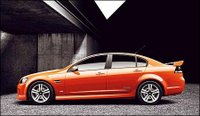
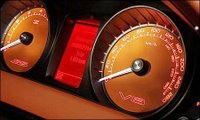

By Peter Palm
Whether you prefer the “home town” designation of Holden Commodore or the local title Chevy Lumina, the important part of this celebrated Australian-built General Motors product is the “SS” badge, which means that a 270 kW 6,0-litre V8 lurks under the bonnet and feeds 530 N.m to the rear wheels only. No smaller engines will be available, and to keep the dealer’s job simple, only four versions of the Lumina will be available - the saloon or Ute with either 6-speed manual or 6-speed automatic transmissions. The saloon’s auto ‘box is USA-developed and offers the option of manually selecting gears, via the gearlever (not paddles) and without override at peak revs. The Ute, on the other hand, uses an automatic transmission with a conventional shift sans manual selection.Apparently, a billion dollars was spent on redesigning the Lumina and styling now receives the Chevrolet family touch with even a resemblance to the much smaller, Korean-built Aveo saloon. Flared wheel arches, a huge rear wing and four tailpipes add the necessary muscular looks to go with the under-bonnet urge.
Read more at Cartoday.com




By Peter Palm
Whether you prefer the “home town” designation of Holden Commodore or the local title Chevy Lumina, the important part of this celebrated Australian-built General Motors product is the “SS” badge, which means that a 270 kW 6,0-litre V8 lurks under the bonnet and feeds 530 N.m to the rear wheels only. No smaller engines will be available, and to keep the dealer’s job simple, only four versions of the Lumina will be available - the saloon or Ute with either 6-speed manual or 6-speed automatic transmissions. The saloon’s auto ‘box is USA-developed and offers the option of manually selecting gears, via the gearlever (not paddles) and without override at peak revs. The Ute, on the other hand, uses an automatic transmission with a conventional shift sans manual selection.Apparently, a billion dollars was spent on redesigning the Lumina and styling now receives the Chevrolet family touch with even a resemblance to the much smaller, Korean-built Aveo saloon. Flared wheel arches, a huge rear wing and four tailpipes add the necessary muscular looks to go with the under-bonnet urge.
Read more at Cartoday.com
Proton Satria Neo

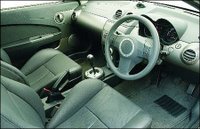
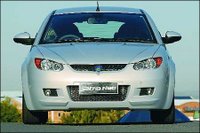
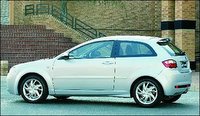
By Gareth Dean
To me, all cars carry an association; Honda Civics remind me of a bovine-related collision I had on an English country road one night, Toyota Hi-Aces have a fist-shaking, expletive-riddled association of being cut up in traffic and Proton… well, I learned to drive in an old Persona Compact with a dodgy gearbox – enough said! Would the Proton Satria Neo be able to undo those memories of smoking clutch plates and bashed alloys?At R134 995, the Satria Neo sits in the same price bracket as similarly engined offerings from Ford and Renault. It is on the specifications front where Proton hopes to get the edge on the competition; ABS with EBD, climate control, airbags, rear parking distance sensors, MP3 compatible CD player with Bluetooth capability, electric windows and mirrors are among the standard features of the car, the only optional extra thus far being leather upholstery at R4 999. A rather vocal 1,6-litre mpi DOHC engine, which generates 82 kW, powers the Satria Neo from 0-100km/h in a claimed 11,56 secs on the way to a 190km/h top speed. This unit is mated with a five-speed manual gearbox with a notchy feel to downward shifts – oh dear, those driving lesson memories have re-emerged!
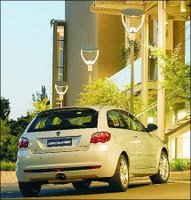
Read more at Cartoday.com




By Gareth Dean
To me, all cars carry an association; Honda Civics remind me of a bovine-related collision I had on an English country road one night, Toyota Hi-Aces have a fist-shaking, expletive-riddled association of being cut up in traffic and Proton… well, I learned to drive in an old Persona Compact with a dodgy gearbox – enough said! Would the Proton Satria Neo be able to undo those memories of smoking clutch plates and bashed alloys?At R134 995, the Satria Neo sits in the same price bracket as similarly engined offerings from Ford and Renault. It is on the specifications front where Proton hopes to get the edge on the competition; ABS with EBD, climate control, airbags, rear parking distance sensors, MP3 compatible CD player with Bluetooth capability, electric windows and mirrors are among the standard features of the car, the only optional extra thus far being leather upholstery at R4 999. A rather vocal 1,6-litre mpi DOHC engine, which generates 82 kW, powers the Satria Neo from 0-100km/h in a claimed 11,56 secs on the way to a 190km/h top speed. This unit is mated with a five-speed manual gearbox with a notchy feel to downward shifts – oh dear, those driving lesson memories have re-emerged!

Read more at Cartoday.com
Subscribe to:
Posts (Atom)
